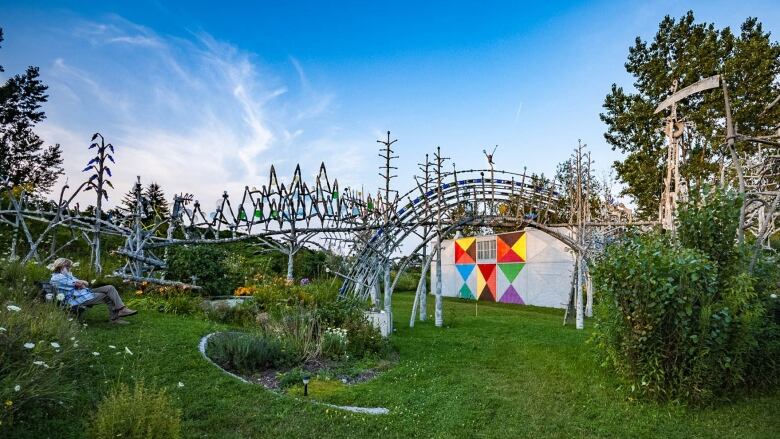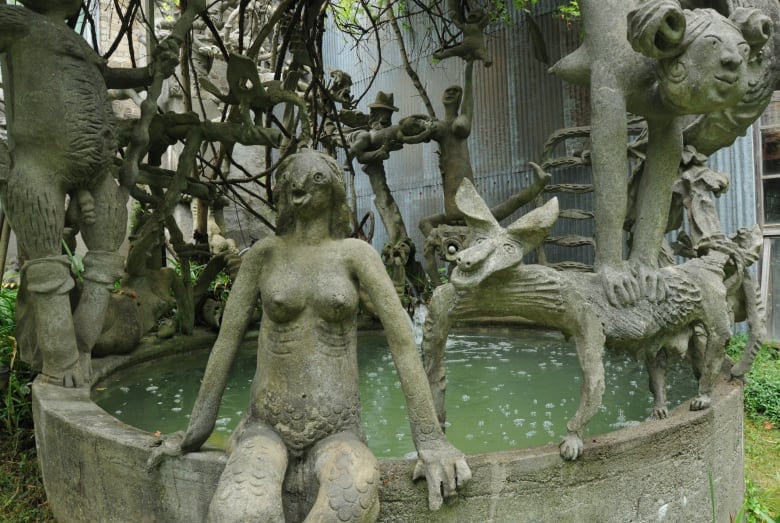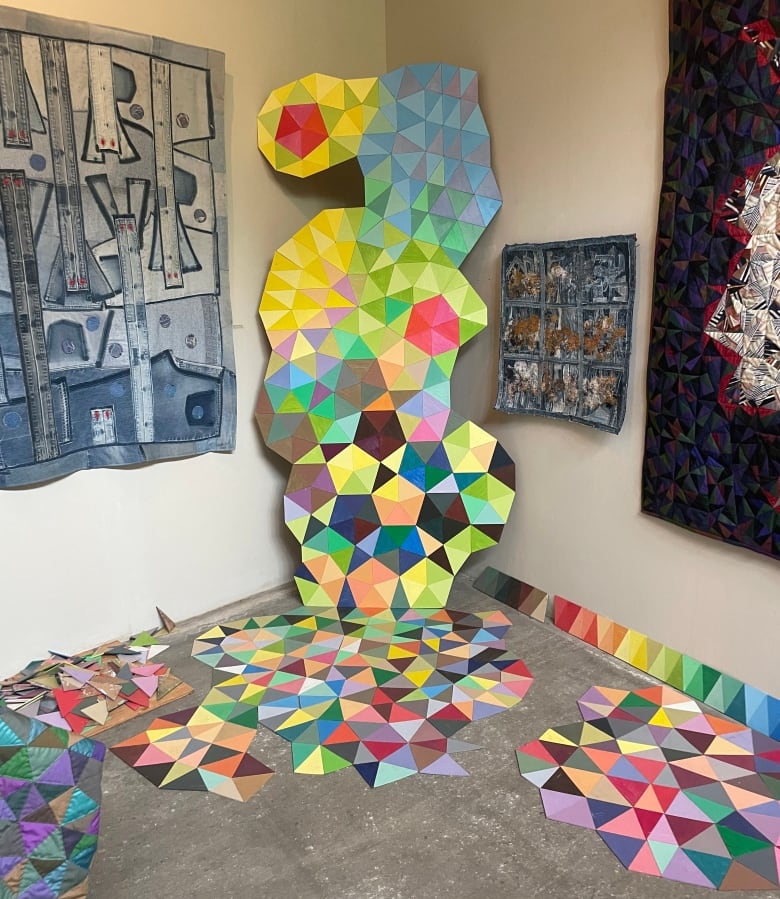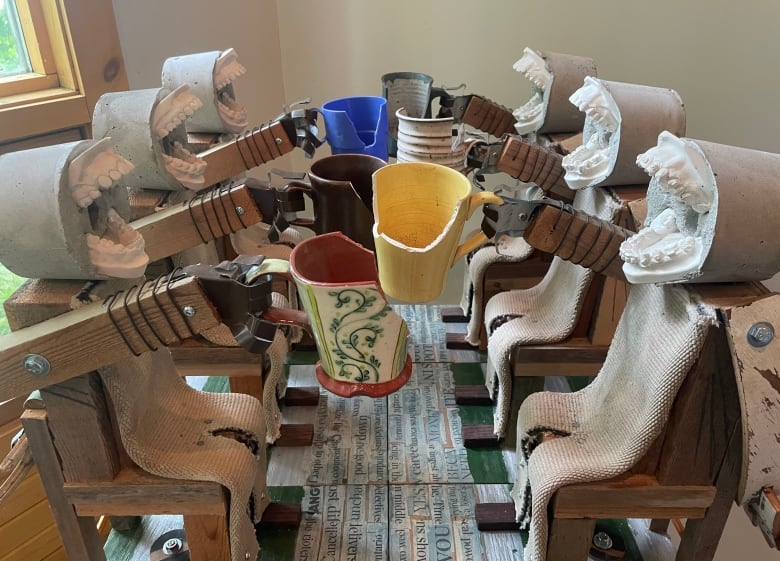In Sunderland, Ont., a fantasyland made of cement, scrap, imagination and time
The Tinkls are an artist couple who live inside their sprawling masterpiece

In the summertime, when the trees make a fortress wall along the country road, the marvel known as Tinkls' Gallery is all but invisible to passersby.
Standing watch just inside the driveway, a sentinel made of scrap tells you you've arrived. Then it's up the path perhaps a bit tentatively for first-timers and through the archway, where Viktor and Judith Tinkl's wonderland unfurls before your eyes.
Explore these under-the-radar Ontario art destinations
- Destination: Art isour masterlist ofunique places to experience art in Canada
- If you're walking around downtown Toronto, these beloved works of art are hidden in plain sight
- A Toronto sculpture park with otherworldly vibes that has been used as a backdrop for music videos from artists likeMartha and the Muffins,Mil-Specand Drake.
- If you want to see great art in Muskoka,take a hike
There, at the artists' Sunderland, Ont., home, a menagerie of stone beasts grows from the exterior of the buildings. Serpents, sprites and winged creatures frolic and lark. Concrete towers and trees reach into the sky. A network of sculptural aqueducts some like skeletons and others like rollercoasters stretch and curl across the 1.2-hectare property, feeding cisterns for the Tinkls' extensive gardens. On a hill to one side, a cluster of cement "cookie" heads resembles a private Easter Island (some so heavy Viktor had to hire a backhoe to right them). Elsewhere, a band made from odds and ends plays for a stone audience seated on bleachers. And guarding the property from the rear, a company of cement and steel soldiers stands four dozen strong.
The density of artwork is dizzying, the scope of vision: unbelievable. Built over nearly six decades, Tinkls' Gallery is a testament to what can be done with an abundance of cement mix, scrap materials, imagination and time.
Although large-scale projects have slowed in recent years, Judith, 81, and Viktor, 87, are still very much practicing artists (with a joint exhibition set to open at the Second Wedge brewery in Uxbridge, Ont., later this week). Each September, the couple open their incredible family home to hundreds of art-lovers for the weekend of the Uxbridge Studio Tour. But Tinkls' Gallery is not just something special to its region; it is a Xanadu unparalleled in the world of Canadian art or anywhere else for that matter.
It all began in 1965, when Viktor bought a nearly 100-year-old schoolhouse, an hour and a half northeast of Toronto. He made the first gargoyle with cement leftover from repair work and set it atop one of the building's buttresses. Judith didn't seem to mind, so steadily the creatures multiplied.
Until then, Viktor's only experience with cement had been as a kid, helping his dad mix the gunk in a wheelbarrow to make a floor. "It was always a learning process," he says. "I didn't know what the hell I was doing. I mean, that's my mantra: I don't know what I'm doing, but I'm going to do it anyway."

As the sculpture project grew, Viktor found a sense of kinship in the creative work of other ambitious outsiders like the Catalan architect Antoni Gaud, Simon Rodia of Watts Towers in L.A. and Facteur Cheval, whose famous Palais Idal in the southeast of France the couple travelled to visit. "They are considered visionaries," he says. "They had stuff that they wanted to get out of their heads. All I had was a bucket of cement and some repairs and eventually it evolved."
Some years beforehand, Viktor graduated from the Ontario College of Art's drawing and painting program. During his time at OCA, he and some schoolmates, including a young Greg Curnoe and Robert-Ralph Carmichael who would design the loonie opened a pioneering exhibition space in Toronto, known as the Garret Gallery. Then, in 1962, the fledgling artist took a job in northern Quebec running the Puvirnituq printmaking studio, an experience which would dramatically change his course in art. The Inuit artists in Puvirnituq were prolific visual storytellers, who created without pretensions to art history or the fads in New York and Toronto.
To keep your spirit in life, you have to make these bloody things. Where it comes from, I don't know.- Viktor Tinkl, artist
When Viktor returned home a few years later, he brought that sense of freedom with him, decamping to the Sunderland schoolhouse, he says, to "cultivate [his] own solitude." There, he developed a personal artistic language rooted more in the wisdom of instincts, feeling and joyous abandon to the muses.
"I don't question too much: Is it good? Is it bad? Does it work or doesn't it?" he explains. "You just wait for the moment that it tells you what to do. You become an intermediary. And that's the great fun of it."

Of course, over the years, Viktor has "played the game," as he puts it. His art has been the subject of touring institutional exhibitions as well as commercial shows with the influential Toronto gallerist Av Isaacs. But he has always found the work happening around his home "a lot more fun."
Today, he and Judith are both retired art school educators a career that helped sustain them as artists over the decades and their home is still abuzz with creative activity. Any visitor will see that this is the calling neither can ever quit.


In an outbuilding Viktor made by hand, the Tinkls have their exhibition space, which Judith ran as a professional gallery through the 1990s. The floors are packed with Viktor's madcap contraptions, including a number of noisemakers that squawk and clank and strum guitar strings. In one room, the walls are lined with large prints by photographer-son Nicholas Tinkl some picturing his father's well-worn tools. Other spaces display art by Judith, a respected and widely-exhibited fibre artist, whose geometric textile and sculptural works climb up and across the walls.
In another building, Viktor's studio bursts with art in every stage of completion. The ceiling of his workshop is a nest for dozens of flying critters made from used paint lids, spent fireworks and other bits and bobs the artist has reimagined. "When I need to make something, I make a bird to take the feeling away," he explains. "To keep your spirit in life, you have to make these bloody things. Where it comes from, I don't know. You need to scratch that itch."
In the same room, another assemblage looks like a vanity table. It was made using an old traffic sign that says "Maximum 80." The sculptor says he found the sign lying on the roadside when he was about 27 years old and held onto it all these years. When he turned 80, he decided to use it in his work. He's attached a bracket with 10 sliding beads, like an abacus, to its backside. When he began the work he figured he'd give himself 10 more years, he says. Each year, he slides another bead over. "I have three more to go."
So what would the Tinkls like to happen to this place their fantasyland once they're no longer around to steward it? A heritage designation? A preservation trust? Do they want it to be frozen in time? No, nothing like that, Viktor says. He'd be happy if it were left to stand until the materials crumble, as they will. He understands that what they've created will be a "burden" to their family and a "challenge" to real estate agents. If he had it his way, everything he's made would magically disappear with him. But maybe, he jokes, some wealthy oil magnate will come "scoop it all up and house the whole thing in a great, big building in Dubai."
The Tinkls know what they've made is special. When many dream of a life in art, they have made a life inside art. They have let their imaginations go gloriously free to chase the creative spirit and built a paradise in the pursuit.
"I guess we are fortunate," Viktor says. "For us, it's been a way of life."
Tinkl' Gallery is open for visits Sept. 14 and 15 for the Uxbridge Studio Tour. Other visits are arranged by appointment only. The artwork of Viktor and Judith Tinkl is on display at the Second Wedge Brewing Co. in Uxbridge, Ont., starting Aug. 23.













_(720p).jpg)


 OFFICIAL HD MUSIC VIDEO.jpg)
.jpg)



























































































